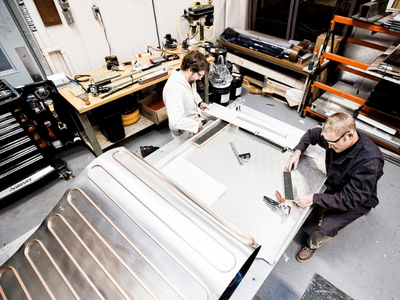One of the top universities in Canada, Queen’s has a long history of discovery and innovation that has shaped our knowledge and helped to address some of the world’s deepest mysteries and most pressing questions, including issues of environmental protection, health care, and the development of advanced technologies. For more than 175 years, Queen’s has brought together and built synergies among leading researchers, scholars, and innovators making a real and measured impact.
The Queen's Partnerships and Innovation (QPI) team develops and facilitates partnerships with industry, governments, not-for-profit organizations, and other academic institutions to advance the research enterprise at Queen’s and the commercialization and protection of inventions, and to strengthen the regional innovation ecosystem in Kingston and Eastern Ontario.
The following profile was originally written by Katie Dupuis and published in Spark Magazine’s Energy, Environment and Engineering edition in the fall of 2022. The article demonstrates the long-lasting, social, economic, and international impact of Queen’s research and collaborations with industry. Using technology assigned to, patented by, and licensed through PARTEQ on behalf of Queen’s, QSBRI commercialized technology developed by Professor Stephen Harrison (now Emeritus) and his team for keeping heat exchangers clean and for controlling temperatures in solar thermal collectors.
QSBR INNOVATIONS
For QSBRI, a research and development firm that focuses on solar thermal energy and heat transfer, their genius is in their simplicity. “We want to design things that will work without user intervention and ideally, without any electricity, with passive mechanical means,” says Ben Stinson, general manager and one of the company’s three co-founders. QSBRI does this in a number of ways where renewable energy and system optimization are concerned, including R&D and market/gap analysis, modeling and simulation, technology development and product testing.
Stinson, along with his two co-founders — president Bob Stinson (Ben’s dad!) and TO/director of engineering Dr. Stephen Harrison — take existing systems and look at ways to improve them through cleantech designs and technology implementation, including technology of their own. “We have some patents and are looking to file new patents that will better optimize processes that are traditionally reliant on fossil fuels,” says Stinson. “We’re essentially doing our best to contribute in ways that use renewable resources and reduce our greenhouse gas emissions.”

QSBRI’s patents include Passive Back Flush (PBF) and Integral Stagnation Control (ICS). PBF allows for the use of compact plate heat exchangers in applications and areas that had previously been impossible due to hard water; the technology prevents fouling and scale build-up. ICS optimizes performance and reliability of solar thermal and photovoltaic thermal (PVT) collectors by preventing overheating.
Despite being a small shop in Kingston, Ont., QSBRI works with government institutions and agencies domestically and abroad, as well as with manufacturers and private contractors. From 2017 to 2019, for example, the company modeled, simulated and built a solar air conditioning unit for King Abdulaziz City for Science and Technology (KACST) in Saudi Arabia. “It was 26 feet long, because it needed a ton of instrumentation, but this was for research to demonstrate that it could work,” says Stinson.
From August of this year until the end of September, Stinson will find himself in Greece, Germany, California and Puerto Rico. “We work in at least two dozen countries every year, because our services are so in-demand. The fact that we’re a small company is actually a benefit, because it means we’re very nimble,” Stinson says. “We have the ability to take on unique and difficult projects that big companies aren’t able to do because they are too customized.”
There’s no shortage of work at home either. “Natural Resources Canada will trust us with just about anything that has to do with solar. We also built a thermal chemical energy storage unit for them. It was very interesting because it was the only one of its kind in the Western Hemisphere,” says Stinson. “We can be flexible and compete with very large institutes from around the world.”
The future looks bright for the crew at QSBRI, with many exciting prospects on the horizon: “We’re working on our PBF technology. We’re working with a global manufacturer of valves to take our technology to the next step. We’ve also seen a huge shift in our industry over the past six to 12 months to storage — electrical and thermal — and many of our current research projects reflect this,” says Stinson. “We’ve also seen a resurgence in solar thermal, so we’re actually doing a gap analysis looking at new tech coming out and what the issues are right now getting the technology into Canadian hands.” If the company’s track record is any indication, the right team is on the job.
 About Vice-Principal Research
About Vice-Principal Research